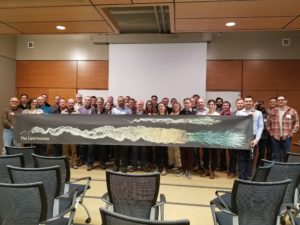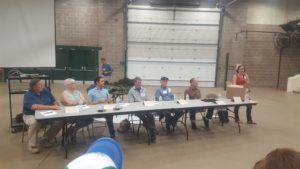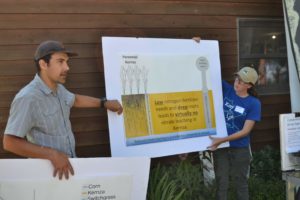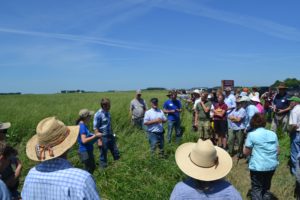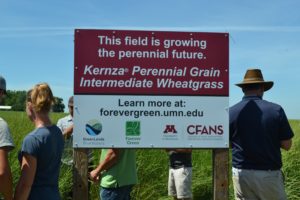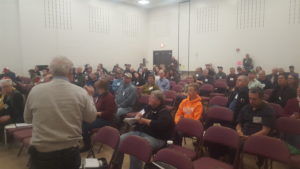Final report for LNC18-406
Project Information
Kernza® (grain harvested from intermediate wheatgrass; Thinopyrum intermedium) is becoming the country’s first widely available perennial grain crop, which has potential to be a profitable alternative crop that greatly decreases the environmental impacts associated with US agriculture. The ecological sustainability of Kernza could be further improved using legume intercropping practices to reduce or eliminate synthetic nitrogen fertilizer requirements and improve soil health. Problems being addressed include a) limited agronomic advice for managing legume/Kernza intercrops to optimize profitability and ecological services regionally, b) a lack of quantifiable soil health metrics resulting from legume/Kernza intercrops and c) insufficient support for farmers to develop and share information and experiences related to Kernza production. This project identified solutions to these problems by conducting research trials on farm and at research institutions to develop agronomic recommendations for managing legume/Kernza intercrops, to quantify the soil health impacts from legume/Kernza intercrops, and to develop and support a Kernza Growers Network for farmers to engage and share knowledge with other farmers and researchers related to Kernza production. Results from our institutional research studies show that legume establishment and productivity varied by species and location. As expected, Sainfoin performed well in KS by producing biomass and not reducing Kernza grain yields more than other legume treatments compared to fertilized monocultures. Alfalfa was also a strong intercrop legume producing well under drought conditions. Slight reductions in Kernza grain yields were measured in all Kansas legume treatments in the establishment year, but no reductions were measured in year two. Sainfoin was not a good legume for the northern environments as biomass was very low. Alfalfa performed well as an intercrop in Minnesota as it resulted in positive N mineralization in year 2, produced consistent biomass yields, and supported Kernza grain yields equal to fertilized monocultures. Alfalfa also dominated in the mixture with red clover and white clover in Minnesota. Legume intercropping with Kernza resulted in similar Kernza grain yields compared to fertilized monocultures in Wisconsin in year one, but yields were lower in year two. There was no effect of legume intercropping on soil aggregate stability in the timeframe of this project. On-farm trials were successfully established and grain yields in the intercropped treatments were similar to monoculture controls in Minnesota. Unlike previous studies, Kernza grain yields did not decline in the third year of production. By the third year, total straw biomass (Kernza plus legume biomass) was greater in the intercropped plots compared to the monoculture in Minnesota. Results from this study were shared broadly at various events, all of which were designed to strengthen the network of Kernza growers and facilitate knowledge transfer from experienced growers to new and future growers. Since starting this project, on-farm partners have become more involved in growing and marketing Kernza and have helped this new crop expand on the landscape and in the marketplace.
Agronomic knowledge of legume-Kernza intercropping systems to improve Kernza yields while reducing costly nitrogen fertilizer inputs. We determined which legumes work well as intercrops in three states and develop recommendations for managing legumes with Kernza. Ecological knowledge quantified soil health impacts of legume intercrops, including changes in nitrogen mineralization. Outreach activities improved grower connectedness and provided education, management documents, field days, and winter workshops. Skills and awareness for farmers to successfully produce profitable Kernza yields without expensive synthetic fertilizers.
Nitrogen fertilizer is applied to millions of acres of annual crops across the US Upper Midwest. Compared to perennials, annual crops have small root systems that limit the crops’ ability to access soil nitrogen and limit its ability to capture and use nitrogen that is applied as fertilizer. Applying nitrogen fertilizer to annual croplands before crop establishment, or on lands upstream and in close proximity to surface waters, or on lands with steep slopes or with coarse structured soils, can result in environmental degradation from nitrate runoff and leaching to waterways. Kernza is a new perennial grain crop that can provide multiple environmental benefits including reduced nitrogen loss while offering farmers a new, economically viable alternative for expanding perennial cover and improving soil health (Culman et al. 2013).
Kernza® is the grain harvested from improved lines of the perennial, cool-season grass intermediate wheatgrass (Thinopyrum intermedium). Plant breeders at The Land Institute and the University of Minnesota have been domesticating this new crop for more than a decade to increase seed size and grain yield. Kernza has high-quality food characteristics (Zhang et al., 2014), which has attracted the attention of food and beverage companies nationwide (DeHaan and Ismail, 2017).
Before the Kernza enterprise can be deployed on a larger scale, research is needed to improve agronomic techniques to increase grain yields, maintain grain yields through time, and to ensure profitability by optimizing input costs and economic returns. Previous research has shown that Kernza requires less nitrogen for grain production compared to most annual crops (Jungers et al., 2017). One additional step towards improving the sustainability of Kernza is to omit all nitrogen fertilizers; which would reduce farmers’ input costs. Intercropping legumes with Kernza could provide the nitrogen needed for productive Kernza yields and add additional environmental benefits.
Quantifying the environmental benefits of Kernza is important for helping individual farmers improve the environmental footprint of their operation, as well as forecasting large-scale environmental benefits that could be achieved if Kernza acreage were expanded nationally. At the farm level, we know that legumes support a variety of soil microbes, which could improve soil fertility through increased nitrogen mineralization (Fornara and Tilman, 2008). The effects of legumes on soil health when intercropped with Kernza largely are unknown. Intercropping legumes to reduce nitrogen fertilizer applied to crops like Kernza could have large-scale positive effects on the environment including a reduction of nitrate leaching and nitrous oxide emissions (Raun et al., 2017).
Cooperators
- (Educator)
Research
Null hypothesis: A range of legume species will establish and persist equally well when fall-seeded with Kernza in multiple different environments varying in soil type, temperature, and precipitation.
Alternative hypothesis: Legume species especially suited to regional environments at the research sites will establish and persist better than other legume species when intercropped with Kernza.
Null hypothesis: A range of legume species will have similar effects on Kernza grain yields when intercropped with Kernza at multiple environments varying in soil type, temperature, and precipitation.
Alternative hypothesis: Legume species especially suited to regional environments at the research sites will result in higher Kernza grain yields in an intercrop compared to other legume species when intercropped with Kernza.
Null hypothesis: Kernza grain yields will be lower when grown with legume intercrops compared to monoculture Kernza fields managed with organic N fertilizer.
Alternative hypothesis: Intercropping legume species especially suited to regional environments at the research sites with Kernza will result in similar Kernza yields compared to Kernza monocultures fertilized with N fertilizer.
Kernza monocultures and legume/Kernza intercrops will maintain similar levels of potential mineralizable N throughout the growing season.
Alternative hypothesis – Legume/Kernza intercrops will have higher levels of potential mineralizable N in the soil compared to the Kernza monocultures throughout the growing season.
Null hypothesis: Kernza monocultures will have similar water infiltration rates and soil aggregate stability values compared to legume/Kernza intercrops.
Alternative hypothesis – Legume/Kernza intercrops will have higher levels of soil water infiltration and aggregate stability compared to the Kernza monocultures.
We conducted two experiments; one was conducted on-farm and another at three institutional research stations, one at each of the three participating states: Minnesota, Wisconsin, and Kansas.
Experiment 1 was an on-farm comparison of Kernza grain and biomass production when grown as a monoculture and as an intercrop. At Minnesota, the legume intercropping treatments included Kernza intercropped with alfalfa, and Kernza intercropped with a mixture of alfalfa, red clover, and white clover. Alfalfa was seeded at a rate of 12 pounds per acre in the alfalfa treatment, while the mixture was seeded at 6, 4, and 2 pounds per acre of alfalfa, red clover, and white clover, respectively. The treatments were randomly assigned to strips, and all were replicated three times. The stands were seeded in late August of 2019 at the Goplen Farm near Canby, MN and Kimber Contours Farm near Farmington, MN. Stands were established using a no-till grass drill but seeded into a prepared seedbed. Three sampling points were assigned in each strip to capture spatial variability. Soil samples were collected from each sampling point in September, 2019 and aggregated by strip. Details on dates and field collection activities can be found in the annual updates section below.
Experiment 2 was established at the Rosemount Research and Outreach Center (UMN), the Arlington Agricultural Research Station (UW), and The Land Institute (KS) in September, 2019. Legume intercropping treatments, as well as fertilized and unfertilized monocultures, are listed in Table 1 below.
Stands were established in early September 2019. Establishment was determined in spring 2020 by counting the number of IWG and legume plants along five 25-cm transects aligned parallel with IWG and legume rows. Poor legume establishment in 2019 at the UMN and UW sites resulted in reestablishment of the studies. To ensure successful legume establishment at these northern sites, IWG was planted in the fall of 2020 and legumes were frost seeded in the spring of 2021. The treatments at all three institutional sites include:
|
Treatment |
IWG row spacing (in) |
Legume seeding rates (lbs/acre) |
|
Kernza narrow fertilized (125 kg N ha-1) |
12 |
|
|
Kernza narrow unfertilized |
12 |
|
|
Kernza wide fertilized (75 kg N ha-1) |
24 |
|
|
Kernza wide unfertilized |
24 |
|
|
Kernza + WC/RC/Alf mix |
24 |
WC = 2; RC = 4; Alf = 6 |
|
Kernza + sainfoin |
24 |
20 |
|
Kernza + WC/BTF |
24 |
WC = 6; BTF = 6 |
|
Kernza + alfalfa |
24 |
12 |
WC = White Clover, RC = Red Clover, BTF = Birdsfoot trefoil, Alf = Alfalfa
At Minnesota, IWG was planted on September 3, 2020 at a rate of 10 lbs. pure live seed per acre with 12 inch spacing between rows at the UMN Rosemount Research and Outreach Center. In the “wide” row treatments and intercropping treatments, every other IWG row was terminated to result in a stand with 24 inch spacing between rows. Row termination occurred on October 1, 2020. Legumes were frost seeded on March 12, 2021. Urea fertilizer was applied on April 20, 2021. At Wisconsin, IWG was planted on September 16, 2020 and legumes were frost seeded on 3/17, 2021.
Net nitrogen mineralization and nitrification rates was determined at three time intervals during each growing season (spring, summer, and fall of 2020 and 2021) (Robertson et al. 1999). This analysis was to determine when and how much nitrogen legumes contribute to the nitrogen needs of the IWG. Two sets of paired soil cores were collected from each plot during each time interval. The first core of each pair was analyzed immediately for nitrate and ammonium using 1 mol L-1 KCl extractions and flow-through colorimetric analysis. The second core of the pair remained in the soil for four weeks before being removed and analyzed for nitrate and ammonium. These methods are in accordance with NSF Long-Term Ecological Research network protocols (https://lter.kbs.msu.edu/protocols/35; Mueller et al., 2013)
Soil baseline analysis was determined using the methods described above for experiment 1. Additionally, soil infiltration, aggregate size, and stability were measured in spring of year 2 and fall of year 3 using the methods advised by the NRCS (Soil Quality Institute, 2001). For aggregate stability, air-dried soil is passed through a 2 mm sieve, then weighed and placed in a set of sieves, where it is slowly wetted and vertically oscillated for 10 minutes. Aggregate and sand materials remaining on the sieve are dried and weighed, then aggregates are dispersed in Calgon solution and remaining sand is weighed. Percentage of water-stable aggregates is calculated as (aggregates - sand)/(total soil - sand) x 100. We also measured soil bulk density using the core method (Blake and Hartge, 1986) at the beginning and end of the study in order to express soil C and N on a mass basis.
Data were analyzed using suitable modern parametric and non-parametric methods based on the distributions they follow. Most response variables were analyzed by location. When appropriate, locations were treated as a fixed effect and tested alone and as an interaction with treatments to determine if treatments affect soil and yield variables similarly across locations. In response to the American Statistical Association’s recent published statement on the use of P-values (Wasserstein and Lazar, 2016), we use a combination of confidence and prediction intervals, in conjunction with P-values, to determine statistical significance of our findings. A priori comparisons of yields across treatments were made using analysis of variance within years.
Establishment of the legumes in the intercropping trials at UMN - Rosemount and UW - Arlington was insufficient to achieve the research goals. The experiment was reestablished at the UMN and UW sites in fall 2020. At Minnesota, IWG was planted on September 3, 2020 at a rate of 10 lbs. pure live seed per acre with 12 inch spacing between rows at the UMN Rosemount Research and Outreach Center. In the “wide” row treatments and intercropping treatments, every other IWG row was terminated to result in a stand with 24 inch spacing between rows. Row termination occurred on October 1, 2020. Legumes were frost seeded on March 12, 2021. Urea fertilizer was applied on April 20, 2021. At Wisconsin, IWG was planted on September 16, 2020 and legumes were frost seeded on 3/17, 2021. Urea fertilizer was applied on May 5, 2021.
Grain yields were measured across treatments at two on-farm sites in Minnesota. Samples were processed in the lab to determine total grain yield on a per acre basis. Biomass was also harvested and was sorted to IWG and legumes. Kurt Kimber harvested grain from his fields in 2020. Gary Goplen did not harvest grain but did harvest the field for forage at grain maturity. In WI, John Wepkin harvested both grain and straw in 2020. Grain is currently being stored before cleaning and dehulling. In Kansas, grain yields were calculated from Don Wagner’s field averaged 270 and 218 pounds per acre in the alfalfa and sainfoin intercrops, respectively. Straw yields averaged 2.25 and 2.12 tons per acre in the alfalfa and sainfoin intercrops, respectively.
Updates from 2021 Field Season:
For the first time in this study, we measured nitrogen mineralization rates in the legume intercropping research plots at the research institutions. Nitrogen mineralization rates are a measure of how much nitrogen is made available for plant uptake through the decomposition of soil organic matter. We expect that more nitrogen will be "mineralized" in plots with legumes compared to those without, and that this will have positive effects on Kernza yields. The method requires incubating soil cores in the field for 28 days. We measured nitrogen mineralization rates from three incubations throughout the year - one in spring, summer and fall. These measurements will be collected again in 2022.
Flag leaf tissue samples were collected from the IWG plants at various stages of growth in 2021. These tissue samples were ground and planned for analysis of N content. This data was supposed to be used for determining N deficit. All tissues samples were sent to UMN for grinding in fall of 2021. Tissue analysis was not conducted because of equipment malfunction (see 2022 update).
Grain yields were estimated by harvesting seed heads and threshing the grain from sampled seed heads. Seed heads were dried and weighed and were threshed. Legume and IWG biomass was harvested from all plots and separated by species. Weed biomass was also harvested and separated from legumes and IWG. Soil samples, grain yields, and IWG and legume biomass yields were collected from the on-farm sites in 2021.
Updates from 2022 Field Season:
Data collection went as planned with the exception of the infiltration rate assessment. Common methods used for this assessment result in highly variable data. New equipment and methods are becoming available, so the project team decided not to conduct the assessment with antiquated techniques.
The nitrogen isotope determination of the IWG flag leaves was not determined because of a malfunctioning laboratory machine. All the samples were prepared and are ready for analysis as soon as the machine is repaired. However, these results will not be available for the time of this final report. Results will be presented in the peer-review paper resulting from this study.
Null hypothesis: A range of legume species will establish and persist equally well when fall-seeded with Kernza in multiple different environments varying in soil type, temperature, and precipitation.
Alternative hypothesis – Legume species especially suited to regional environments at the research sites will establish and persist better than other legume species when intercropped with Kernza.
Results - Legume establishment was poor at all three sites during the first attempt at planting in fall 2019. A combination of dry fall conditions and low fall temperatures likely resulted in seedling establishment rates that were unacceptable for a research study. The experiment was successfully re-established in fall 2020. Legume establishment was determined at all sites by measuring total legume biomass at the time of Kernza grain harvest. For legume mixtures, legume biomass was reported as a composite of all legume species in the plot. Additional measurements were taken in Minnesota to assess legume establishment and productivity, including a plant survey in June that recorded individual plants per unit area, an assessment of ground cover of each legume species within each plot, and after legume biomass was harvested, it was separated by species to measure the relative abundance of each legume species within the mixtures.
Analysis of total legume biomass in year one was conducted to determine variability of establishment across sites. An interaction between legume treatment and location was significant (P < 0.001) for total legume biomass in year 1, which indicated that not all legume species established the same across sites. This means that we accept our alternative hypothesis and proceed to assess legume establishment by location.
Legume Establishment and Persistence in Kansas
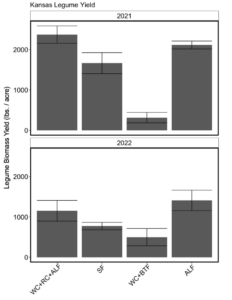
Three legume intercrop treatments - sainfoin, alfalfa, and the white clover, red clover, and alfalfa mix (RC+WC+alf) - established well at Kansas and were similar in biomass yield at 2052 lbs./acre. The white-clover, birdsfoot trefoil (WC+BTF) treatment yielded 85% lower (314 lbs./acre) than the other three treatments in year 1 (2021).
Legume biomass was generally lower in year 2 (2022) compared to the establishment year (2021), but differences in treatments were similar. In year 2, the WC+BTF treatment yielded 500 lbs./acre, similar to the sainfoin (778 lbs./acre) and RC+WC+alf treatment (1153 lbs./acre). The alfalfa treatment yielded more than the WC+BTF, and on average was 1411 lbs./acre.
For growers hoping to maximize legume biomass in an intercrop with Kernza in Kansas, our results show that any of the these three treatments - sainfoin, alfalfa, or RC+WC+alf - would likely be better choices than a WC+BTF mix. Establishment was strong for these three treatments. When considering the top three legume intercrop treatments, growers may want to consider the RC+WC+alf mixture to increase species diversity in the system. Increased diversity of legume intercropping mixtures can broaden the range of time that nitrogen is fixed and transferred to Kernza (Crews et al., 2022; Reilly et al., 2022), and offer more pollinator resources (Cole et al., 2022), and can support increased microbial diversity (Li and Wu, 2018). The effect of these legume species on Kernza yields when intercropped is described in sections below.
Legume Establishment and Persistence in Wisconsin
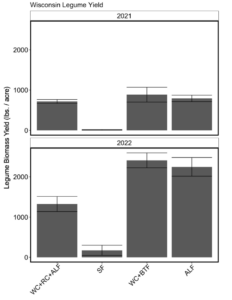
At Wisconsin, the alfalfa, WC+BTF, and RC+WC+alf treatments had legumes that established moderately well with an average biomass yield of all three treatments = 799 lbs./acre, while the sainfoin treatment established poorly and biomass was significantly lower (12 lbs./acre) than the other treatments.
Legume biomass increased in year 2 (2022) at Wisconsin. Alfalfa and WC+BTF had the highest biomass yield (average = 2328 lbs./acre), which was significantly greater than RC+WC+alf (1325 lbs./acre) and sainfoin (175 lbs./acre).
For growers hoping to maximize legume biomass in an intercrop with Kernza in Wisconsin, our results show that either the alfalfa or WC+BTF would likely be better choices than sainfoin or the RC+WC+alf treatments. Also at this location, one of the top treatments included more than one legume species, so an option to increase species diversity is available. The effect of these legume species on Kernza yields when intercropped is described below.
Legume Establishment and Persistence in Minnesota
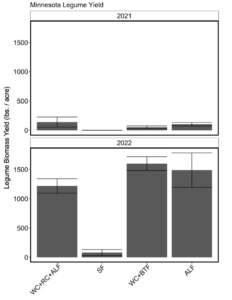
Legume establishment based on biomass at IWG harvest was poor for all treatments in Minnesota, likely a result of the historical drought that occurred during that growing season (2021). In year 2, legumes recovered and biomass was moderate at IWG harvest. The alfalfa, RC+WC+alf, and WC+BTF yields were statistically similar and averaged 1436 lbs./acre. Sainfoin biomass remained low at 81 lbs./acre.
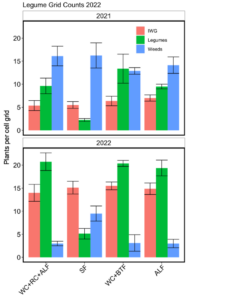
During the first spring, the year after establishment, plant counts were conducted in MN to better understand legume establishment relative to the IWG and weed pressure within the plots (see methods for details). We found that the number of legume seedlings was greater than IWG seedlings in all treatments except for sainfoin, and weed seedlings were equally abundant across treatments and simlar or greater than legume seedlings. This suggests that legume establishment was strong, but the drought likely reduced legume productivity and thus legume yield in year 1 (2021). In year 2, both legume and IWG seedling abundance increased and weeds decreased, with treatment differences similar to those in year 1. The reduction in weed pressure is a testement to the positive outcomes of a perennial grain/legume intercropping system.
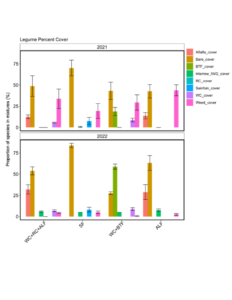
The percent of gound cover in between planted IWG rows covered by legumes, weeds, and nothing (bareground) was assessed in summer each year in MN (Figure 5). These data are useful for understanding legume growth dynamics throughout the season. In year 1, bareground and weeds occupied most of the interrow space in all treatments, however legumes were observed and present going into IWG harvest. In year 2, weed cover was reduced in all plots, bareground was reduced in the WC+BTF, and legumes changed differently across treatments. Alfalfa and BTF increased in percent cover from year 1 to 2 in all treatments where these species were planted.
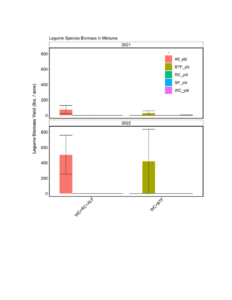
Although the RC+WC+alf and WC+BTF treatments were seeded with multiple species, a single species prevailed and dominated each mixture. For the RC+WC+alf treatment, alfalfa represented nearly all of the legume biomass in the intercrop, and for the WC+BTF treatment, BTF represented nearly all of the legume biomass in the intercrop. White clover was rarely observed in any treatment, thus this species does not appear to establish well or persist when seeded with other legume species in mixture for intercropping with IWG in MN.
- Kernza grain yields in response to legume intercropping
Null hypothesis: A range of legume species will have similar effects on Kernza grain yields when intercropped with Kernza at multiple environments varying in soil type, temperature, and precipitation.
Alternative hypothesis: Legume species especially suited to regional environments at the research sites will result in higher Kernza grain yields in an intercrop compared to other legume species when intercropped with Kernza.
Results
At each site, we found that that Kernza grain yields were similar among all legume intercropping treatments in year 1 (2021) and in year 2 (2022). This is a notable finding, that legume treatments that had high levels of legume biomass did not result in higher Kernza grain yields. The impacts of legumes on Kernza grain yields can be both positive and negative. Positive impacts of legumes on Kernza grain yields would come if the legumes can fix adequate levels of nitrogen, and if that nitrogen can be made available to the Kernza at times when N demand is high (through mineralization, see results below). Other benefits could be related to weed or possibly pathogen suppression by legumes. On the other hand, legumes can also compete with Kernza for other resources such as soil moisture and light. These positive and negative interactions appear to have balanced out for most legume treatments. This means that a grower can feel relatively confident in planting one of the legume species tested here with Kernza to achieve environmental sustainability goals without concerns for drastic yield reductions. However, Kernza grain yields from intercropped systems should also be compared to Kernza monocultures managed with N fertilizer to determine differences in profitability, which is described below.
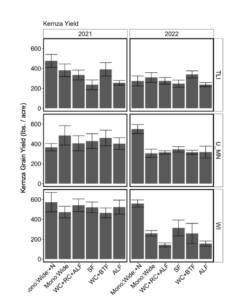
Null hypothesis: Kernza grain yields will be lower when grown with legume intercrops compared to monoculture Kernza fields managed with organic N fertilizer.
Alternative hypothesis: Intercropping legume species especially suited to regional environments at the research sites with Kernza will result in similar Kernza yields compared to Kernza monocultures fertilized with N fertilizer.
We found that N fertilizer applied to Kernza monocultures only increased grain yields in year 2 compared to the unfertilized monocultures (Fig 7), and that increase was only observed at MN and WI. Our goal was to determine if legumes could provide enough N (or other benefits) to Kernza to equal yield gains observed in monocultures managed with synthetic N fertilizer. To achieve this, we calculated the “relative yield” by dividing grain yield from each intercropping treatment by yield in the monoculture fertilized with synthetic N (see methods for equation and additional explanation). Relative yield (RY) values greater than 1 indicate treatments that yielded more than the fertilized monoculture, while RY less than 1 indicate treatments that yielded less than fertilized monocultures. The RY is presented for each legume treatment across sites and years in Fig 8, and the red line indicates where RY is equal to 0. We used the 95% confidence intervals to determine if the RY values are significantly different from 1. Therefore, if the 95% confidence interval error bars overlap the red line (where RY=1), then the RY is assumed to be statistically equal to 1 and that Kernza grain yields from that treatment are similar to the fertilized monoculture.
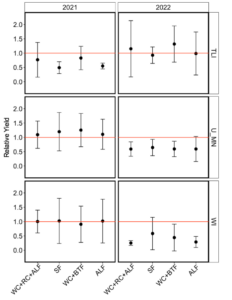
Kansas results: In year 1, Kernza RYs were equal to 1 for the WC+RC+Alf and WC+BTF treatments and less than 1 for the sainfoin and alfalfa treatments. Of the treatments that resulted in Kernza yields similar to the fertilized monoculture, the WC+RC+Alf differed from the WC+BTF in that the WC+RC+Alf produce substantially more legume biomass than the WC+BTF. This suggests that the mechanisms underlying the effects of legumes on Kernza yields may have differed between these treatments. Additional analyses described below add insight to these differences.
In year 2, RY was equal to 1 for all legume intercropping treatments. This suggests that legume intercropping, and benefits in terms of crop diversity, do not jeopardize a grower’s ability to profitably produce Kernza grain compared to a fertilized system. Notable is that the error bars are rather large and indicate substantial variability in the average RYs, and that fertilized monocultures (the baseline for comparison here) did not differ from the unfertilized monocultures.
Minnesota results: In year 1, RY was equal to 1 for all legume intercropping treatments at Minnesota. Relatively high Kernza yields across treatments corresponds to low legume biomass yields in year 1. Therefore, it is unlikely that legumes competed much with Kernza and thus did not reduce grain yields. However, it is also unclear how beneficial the legume intercrops could be in terms of N provisioning in year 1. Assessment of the N mineralization patterns and additional analyses below add insight to these questions.
In year 2, RY was less than 1 for all legume intercropping treatments at Minnesota except for alfalfa, indicating that most treatments resulted in lower Kernza grain yields compared to the fertilized monoculture. This result corresponded with a substantial increase in legume biomass for all treatments except sainfoin. Therefore, competition for resources such as soil moisture may have been stronger than any benefits such as N fixation and transfer. However, lower RY was observed even in the sainfoin treatment, which also had very low legume biomass production, so other plant/soil/environmental interactions may be occurring to drive this result.
Wisconsin results: Results at Wisconsin were relatively similar to those observed at Minnesota in both years; Kernza yields from intercropped treatments were similar to those from fertilized monocultures in year 1. In year 2, Kernza yields from intercropped treatments were less than those from fertilized monocultures with the exception of one treatment, which was the sainfoin intercrop at WI. Here, sainfoin produced very little biomass which may have limited the species’ ability to compete with Kernza for other resources relative to the other legumes species in the other treatments.
- N Mineralization
Kernza monocultures and legume/Kernza intercrops will maintain similar levels of potential mineralizable N throughout the growing season.
Alternative hypothesis – Legume/Kernza intercrops will have higher levels of potential mineralizable N in the soil compared to the Kernza monocultures throughout the growing season.
Nitrogen mineralization (N min) was measured in plots to determine how much nitrogen was made available for uptake by crops during a specific period of time. Mineralization describes the process of converting N bound in organic molecules (dead plant tissues, microbial cells, soil organic matter) to inorganic forms - namely nitrate (NO3- ) and ammonium (NH4+) - that are available for plant uptake. We expected that legumes would increase N min by directly adding N-rich molecules to the soil via rhizodeposition, dying root tissue, and senesced stem and leaf tissues (aboveground biomass residue) – all of which can be relatively high in N concentration because of the ability for legumes to fix N from the atmosphere. N min can vary within a year depending on temperature and precipitation patterns, so we took measurements multiple times throughout the growing seasons. In year 1, N min was measured in May and August at KS and MN, and a third time in June at MN. N min was not measured at WI in year 1. In year 2, N min was measured at all three sites in May, in May and Aug at KS and MN, and again in May, June, and Aug in MN. The results are presented by site below.
Kansas results: Nitrogen mineralization was similar among legume intercropping treatments in May of year 1 (Fig. 9), which was expected given that legumes had not yet gone through an entire growing season and were relatively small at the time of sampling. Only the WC+RC+Alf treatment resulted in N min rates that were significantly different from 0, and in this case averaged 0.13 mg N/kg soil/day. In August, the WC+RC+Alf treatment still had positive N min rates, and while the estimates increased in all treatments, none of those were significantly different from 0. The WC+RC+Alf treatment also produced the most legume biomass in 2021, thus it is not surprising that this treatment also resulted in the highest soil N mineralization rates. In year 2, there was no indication of N min during the May sampling time, and in August, the WC+BTF was the only treatment that had positive N min significantly different from 0. Contrary to what was observed in year 1, this treatment produced relatively little legume biomass compared to other treatments.
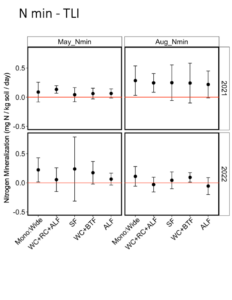
Wisconsin results: N min data was limited at WI and showed no rates significantly different from 0 across treatments (Fig. 10).
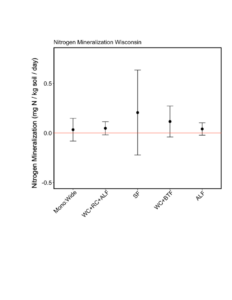
Minnesota results: N min in May of year 1 was negative for all treatments, which could be related to early season microbial growth and uptake of available N (Fig. 11). By June, N min was positive for WC+RC+Alf and WC+BTF, and although values sainfoin and alfalfa were similar, these treatments were not significantly different from 0. By August, N min appeared to have decreased but was still positive for sainfoin. In May of year 2, N min was positive for all treatments except sainfoin. The higher N min rates in May of year 2 compared to year 1 could be related to an accumulation of legume root and aboveground biomass residue that remained at the end of the first year growing season, which was then available for decomposition in spring of year 2. Similar positive N min rates were observed in June and August, however N min in WC+BTF was not significantly different from 0 in August.
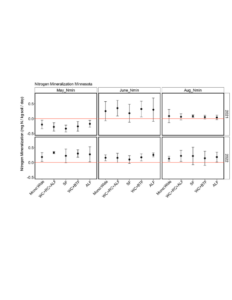
Kernza monocultures will have similar water infiltration rates and soil aggregate stability values compared to legume/Kernza intercrops.
Alternative hypothesis – Legume/Kernza intercrops will have higher levels of soil water infiltration and aggregate stability compared to the Kernza monocultures.
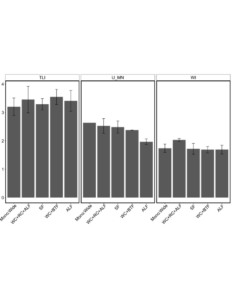
The stability of soil aggregates is positively associated with water and gas transport in soils, crop rooting, and soil microbial activity. Aggregate stability was measured once at the end of the year 2 at all locations. The mass of aggregates in four different soil aggregate size classes was similar across all treatments at all locations. A composite measure is the mean weight diameter (MWD), which was also similar for all treatments at all locations. A lack of differences in aggregate stability is not especially surprising given that the measurement was taken only two years after establishment. This response variable can be slow to change. We hypothesized that differences might be observed after three years of production, but the failed establishment in year 1 set this project back enough that this hypothesis was not able to be adequately tested. Similarly, water infiltration is a test that can be highly variable and slow to change in response to management. For this reason, water infiltration was not measured after two years of Kernza/legume intercropping in this study.
Results from On-Farm Research
Minnesota on-farm Results
The on-farm trials successfully established in 2020 at two sites in Minnesota, the Goplen Farm in Canby, MN and the Kimber Contours Farm in Farmington, MN. Both sites tested three treatments, a Kernza monoculture, Kernza intercropped with alfalfa, and Kernza intercropped with a legume mix (alfalfa, red clover, and white clover). In year 1 (2020), Kernza grain yields were significantly greater in the monoculture (959 lbs./acre) compared to either intercropping treatment (585 lbs./acre) averaged over both farms (Fig. 13). In years 2 and 3, grain yields were similar among all treatments at both farms. Yields did not decline dramatically as seen in other studies and averaged 444 lbs./acre in the third year.
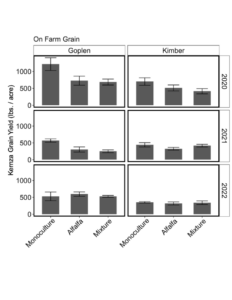
Legume biomass was measured at the time of Kernza grain harvest to estimate the establishment and persistence of the legume intercrops. Legumes established well at both sites. At the Kimber Farm, the trial was planted in a field following red clover, and some volunteer red clover persisted after an attempt of mechanical termination the previous year. As a result, figure 14 and 15 shows that nearly 1,150 pounds of legume biomass was present in the monoculture treatment in year 1 (Fig. 14). In year 2 (2021), legumes persisted at the Kimber Farm but were largely dormant at the Goplen Farm as a result of the drought, thus no data on legume biomass are available for that site in 2021. Legume biomass was surprisingly similar in year 3 (2022). The legume biomass values observed at these sites, and the stability of values through time, is an indication that the approach to establishment and management was successful for a Kernza intercropping system.
Although red clover was observed in year 1 in the mixture treatment at both farms, presence of this species decreased with time as alfalfa became the dominant legume species in the mixture (Fig. 15). White clover biomass was almost negligible, but that may not preclude growers for incorporating it into mixtures. White clover is a low-laying species that can be present without contributing significantly to biomass, and the presence of this species can offer ecosystem services such as pollinator resources in early spring.
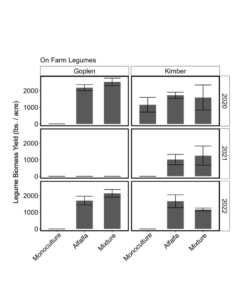
Figure 14. Legume biomass yields (lbs./acre) by intercropping treatment at two farms in 2020, 2021, and 2022.
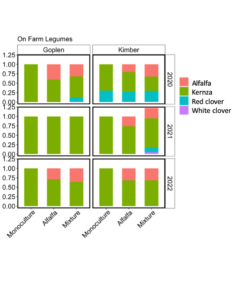
Some Kernza growers are also interested in harvesting and selling the post-grain harvest straw, which can have value for livestock rations or bedding. We measured Kernza straw, legume biomass, and the sum of both biomass constituents (hereafter referred to as total biomass). Kernza straw and total biomass were similar among treatment when averaged over farms and years (Fig. 16 & 17). However, total biomass was greater for both legume mixtures compared to the Kernza monoculture in year 3 (2022; Fig 17). This is important for producers who might consider converting their Kernza grain production fields into hay or forage systems after grain yields decline in aging stands.
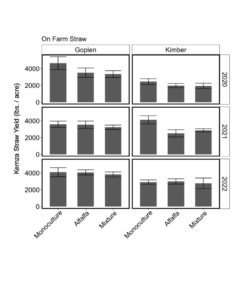
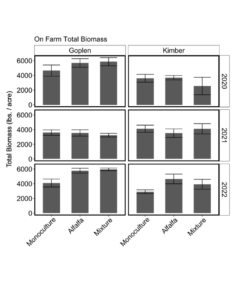
Soil samples were collected at the start of the experiment in 2020 and the end in 2022 and analyzed for total carbon (C), nitrogen (N), and organic matter (OM). Figure 18 shows the change in these soil parameters through time. Points and error bars that overlap the red line indicate parameters that did not change over the course of the study. Importantly, we did not see any changes in total C or OM in any treatments. We did observe an increase in the soil C/N ratio in the mixture treatment, and a slight but non-significant increase in the other treatments, at the Goplen farm. This suggests that soil nitrogen may have become more limiting as stands aged.
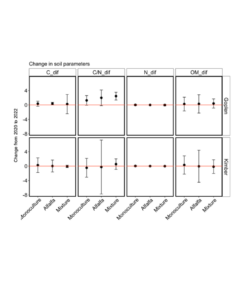
Wisconsin on-farm results
The on-farm trial was established in 2019 at John Wepking’s farm in Wisconsin. Three intercropping treatments were tested, Kernza intercropped with alfalfa, Kernza intercropped with white clover, and Kernza intercropped with a legume mix (alfalfa and white clover). The grower had challenges harvesting Kernza grain due to a high frequency of volunteer winter rye in this trial. The Kernza grain harvested with a combine could not be cleaned and the producer decided to use the directly harvested biomass for livestock feed. Therefore, yield estimations from combine harvest are not available for this trial.
In 2021, Kernza grain yield, Kernza straw, legume biomass, and weed biomass were sampled approximately at physiological maturity on August 5, from a 0.3 m2 quadrat randomly placed in each plot. The quadrat was placed so that two rows of IWG and two interrows of 1 mt long were harvested. Grain yield was determined by cutting the spikes from all tillers within the quadrat. Spikes were dried at 35°C for seven days, threshed with a mechanical seed thresher, and weighed. Aboveground biomass was cut by hand, separated into IWG forage, legume forage, and weeds, dried at 60°C for at least 5 days, and weighed. The intercropping treatments didn’t show differences on grain yield (244 lbs/acre, on average), IWG forage (3,623 lbs/acre, on average), or weed biomass (300 lbs/acre, on average). Legume biomass was consistently higher than weed biomass in all the treatments. Alfalfa biomass was 3,397 lbs/acre and 2,245 lbs/acre, when Kernza was intercropped with alfalfa, or alfalfa+white clover, respectively. White clover biomass was 610 lbs/acre and 245 lbs/acre, when Kernza was intercropped with white clover, or alfalfa+white clover, respectively.
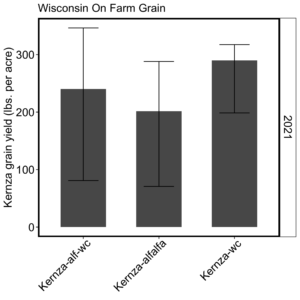
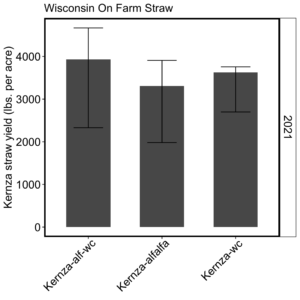
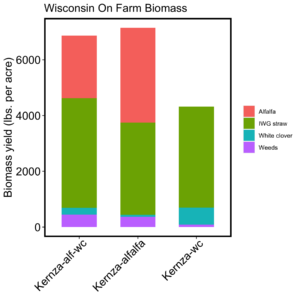
In 2022, Kernza grain yield, Kernza straw, and weed biomass were sampled at physiological maturity, from 0.5 m2 quadrat. Kernza grain yield showed a decrease of 70 % compared to the 2021 year (244 vs 73 lbs/acre), and Kernza straw decreased 60 % (3,623 in 2021 and 1,484 lbs/acre in 2022). The weed biomass remained relatively constant (325 lbs/acre). Data per treatment is not available for this year.
Kansas on-farm results
One KS grower, Brandon Kaufman, experienced many challenges when planting Kernza after winter wheat in 2019 and, while the producer waited and sprayed the first flush of volunteer wheat, in the end there was so much volunteer that no grain was harvested in 2020. In 2021, the Kerza appeared to have recovered. The monoculture areas planted on 7.5 inch rows averaged about 190lb/acre with 80 units of N applied. Summer 2021 all the biomass was removed after harvest and 60 units N applied in fall and 30 units N applied in spring. A severe outbreak of army worms decimated the fall biomass regrowth 2021, which carried over to sever spring regrowth issues in. Subsequently, bindweed took over and the Kernza looked stressed and N deprived. It yielded 80lb/acre in this third year. The portions of the field originally planted with legume intercrops looked healthier throughout the project. Much of the sainfoin winter killed in the first fall 2019 because lack of fall rain resulted in late establishment. The wide IWG rows, which lacked a sainfoin companion looked healthier than any other part of the field. The alfalfa also winter killed in 2019, but enough survived that there may have been 1 plant per square foot by the end of the 2022 growing season.
A second on-farm site was monitored. Results from quadrat sampling in the treatments from Don Wagner’s farm are below.
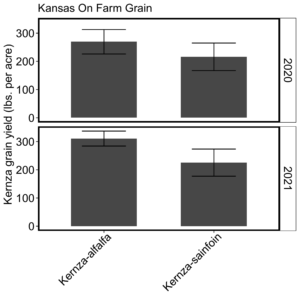
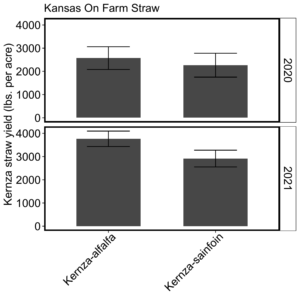
No single legume species stood out as ideal for intercropping with Kernza across sites and farms. Alfalfa established well and persisted at all three sites, whereas sainfoin only established well at Kansas and is likely a more suitable species for water limited regions. Alfalfa was the dominant species in legume mixtures with red clover and white clover, while birdsfoot trefoil emerged as a dominant species when mixed with white clover. No legume species or mixture increased Kernza grain yields relative to fertilized or unfertilized monocultures, and in some instances (certain site/year combinations, e.g. MN and WI in year 2), intercropped Kernza yields were lower than fertilized monocultures. Results from the soil nitrogen mineralization assays suggest that legumes may not have increased soil available nitrogen for Kernza uptake compared to the monocultures within the first two years of this study, but these results are in line with other recently published studies that indicate a lag effect of nitrogen transfer from legumes to Kernza in intercropping systems (Crews et al., 2022; Reilly et al., 2022). Soil aggregate stability, and important indicator of soil health, was similar among treatments. Kernza legume intercrops were successfully established on four farms, and data from Minnesota shows that legume biomass contributed to significantly more total biomass by year three in the intercrops compared to monocultures.
Education
Educational outputs of this this project reached growers, state agency lang managers, end-users, and the general public. This project supported networking and knowledge exchange of producers though field days, winter workshops, and events at conferences like Marbleseed (formally Moses) and the Minnesota Organics Conference. Project partners disseminated findings from their research by presenting to practioners and other scientists at the annual Kernza conference in 2020, 2021, and 2022. The general public learned about Kernza and this work during the first ever Kernza Fest, in which GLBW and UMN participates tabled to disseminate information.
Project Activities
Educational & Outreach Activities
Participation Summary:
This project meeting provided an opportunity to introduce project co-PI Tim Crews (KS) to MN on-farm trial partner Kurt Kimber. The meeting was held in the Kernza - legume intercropping trial at the Kimber farm. This was an important opportunity for researchers and farmers to observe and discuss the current status of the plots as well as the long-term visions and goals for perennial grain cropping systems. This meeting resulted in highlighting future research priorities.
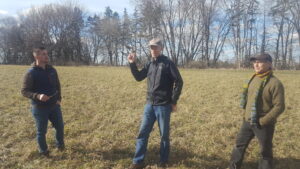
All project co-PIs participated by presenting content at the Annual International Kernza Conference held virtually in 2020. Project PI. Jungers discussed grazing potential of Kernza and referenced legume intercropping, Picasso presented on Kernza forage potential, and Crews presented on Carbon Sequestration. Project farm partner Brandon Kauffman presented on his work towards Kernza commercialization. These presentations can be viewed at https://kernza.org/watch-the-2020-kernza-meeting/
Project members Crews, Picasso, Gutknecht, and Jungers all presented research findings at the 2022 Kernza Conference held in Salina, KS. Crews and Gutknecht shared results from various studies and described the role of legume intercropping with Kernza to achieve environmental outcomes. Jungers and Picasso presented results from various agronomic experiments including preliminary results from this study. Connie Carlson organized a researcher/grower meeting during the conference which resulted in a priority list for future studies.
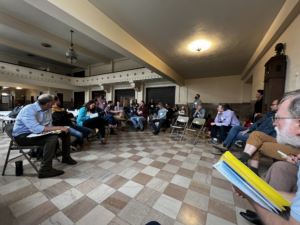
A field trip to the on-farm trial on the Kaufmann farm was hosted by project partner Schlautman. The audience heard Kaufmann explain why was interested legume intercropping with Kernza, and his description of how the system could benefit a dual-use grazing system.
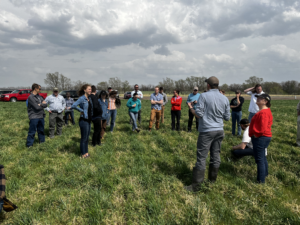
A field day was co-hosted by partners Connie Carlson and Al Kraus from Clean River Partners and took place at the SARE on-farm trial at the Kimber farm on July 21, 2022. The event attracted 54 people. Veteran Kernza growers including Carmen Fernholz and Kurt Kimber demonstrated how to set a combine to harvest Kernza to the audience, which included some new and future Kernza growers. UMN graduate student Alex Griffin presented preliminary results from this study to the audience (PI Jungers fell ill just prior to the event).
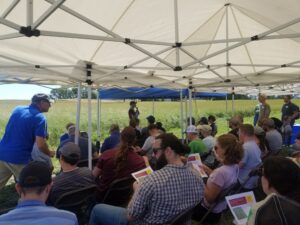
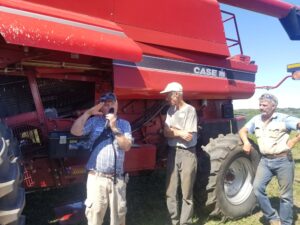
Learning Outcomes
- Overview of Kernza
- Kernza Agronomics
- Intercropping legumes and Kernza
- Potential environmental impacts of perennial grain/legume intercropping
- Grower networking and support to adopt perennial grain crops
Project Outcomes
Planted Kernza for production.
A regional Grower's Cooperative formed around Kernza in 2020. Members of this co-op, called the Perennial Promise co-op, include participants in this project's Kernza Growers Network and an on-farm research participant (Kimber). Some of these participants were first introduced to Kernza from this SARE project, which highlights the critical role these projects play in network building.
In Kansas, the on-farm participant on this project (Kaufman) founded the company Sustain-a-grain, a licensed Kernza growing, processing, and sales company. The experienced he gained growing Kernza as part of this study helped him form a company that would make Kernza more accessible to farmers and consumers in the southern Midwest region.
Project participants initiated a new multi-site Kernza legume intercropping trial with a group of researchers in Eastern US focused on organic production that was designed using experiences learned from this study. A second new legume intercropping trial was established among this current set of research partners as part of the USDA Sustainable Agricultural Systems KernzaCAP grant; again using information learned from this study.
